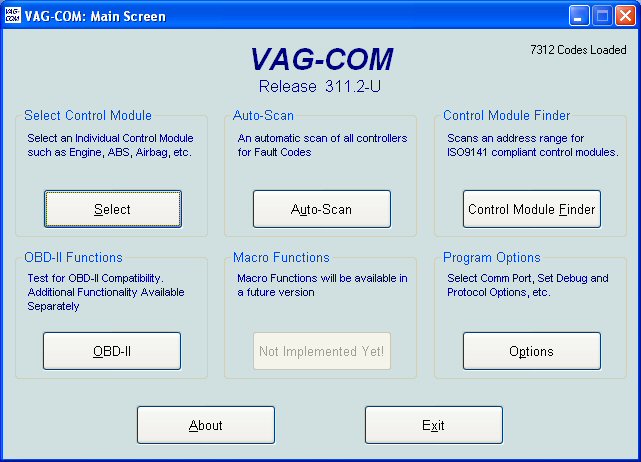
VAG-COM
View live sensor values in real time.
NOTE: all the information presented is personal opinion and
presented in good faith, nothing on these pages is validated or endorsed by Audi
and you should be aware that you could make changes that may disable features of
your car.
Always note down the original setting of anything you do and if you are not
confident with what you are doing then just don't do it.
YOU HAVE BEEN WARNED.
One of the neat features of VAG-COM is the ability to view and log various sensor readings in real time to see the output for diagnostic purposes.
Select the Control Modules

Typically most modules to log are under the "01" Engine option.
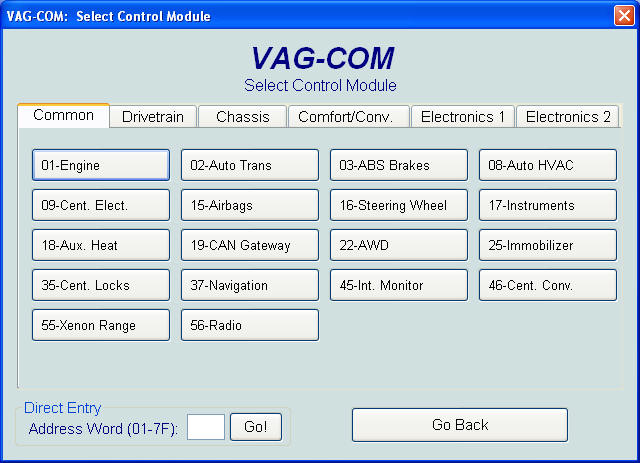
Select the "08" Measuring Blocks

The following screen is displayed, 4x3 groups can be logged, in each of the Group boxes select a group number that best serves the logging that you want to do.
The following screens represent groups I tend to use but there are many more and some experimenting may reveal some better ones.
003- Has RPM and Air Mass Flow - good for Air Mass Meter
diagnosis
005 - vehicle speed - just useful for reference
011 - Coolant and intake temperature - good for comparison against revs and
vehicle speed.
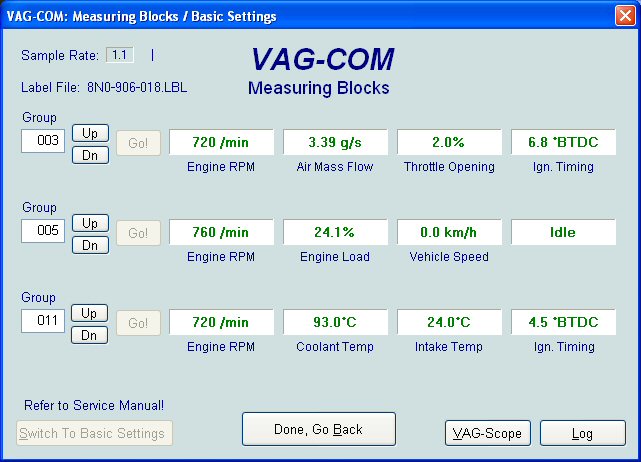
115 - command boost and intercooler boost pressure -
Block 115 will show you a reading in the 3rd and 4th column, requested boost and
actual boost in millibars (1000 mbar = 1 bar). You will have to subtract about
1000mbar from both columns since atmospheric pressure is around that level. What
is left is the boost request (boost that the ECU wants to "see" in the intake
manifold) and actual boost (actual boost pressure at the intake manifold). The
ECU controls the turbo wastegate and will modulate it to get actual boost as
close to requested boost (following the rev/load map of the chip) as possible.
Under sustained full throttle, actual boost should not deviate more than
100millibar from requested boost. If it does, then something is wrong. It is
normal to have larger differences in these two numbers under shifting and under
throttle application/de-application as it takes some time for the wastegate to
react to commands. However, under sustained full throttle, assuming the road
gradient doesn't change much, the two numbers should be very close to each
other. The closer, the better.
118 - N75 Wastegate
Column 3 on Block 118 will show you percentage duty cycle on the N75 valve. The
N75 is the valve that plays a large part in regulating the wastegate. An
unenergized solenoid (0% duty cycle) permits full charge pressure on actuator
diaphragm. So the turbocharger naturally regulates itself. As boost builds, the
wastegate opens. The ECU can operate the N75 to vent some of this pressure so
the wastegate either does not open, or opens less. For example if reading is
62.8% duty cycle it means over a 100 millisecond period (1/10 of a second) the
charge pressure in the actuator line was filled for 37.2 milliseconds and vented
for 62.8 milliseconds. An orifice in the charge pressure connection restricts
the flow rate of charge air into the actuator system. If you are seeing a large
difference between the two reading off block 115 (request high, actual low), and
you see that duty cycle on the N75 is high (90-100% range), then you are
probably leaking boost from a pressure hose (turbo outlet to intake manifold) or
the diverter valve (DV). You should then check all clamps and hoses along the
whole pressured tract as well as swap DVs
120 - Net Torque - Torque output -
Column 3 on Block 120 will show you calculated torque at the crankshaft in Nm.
This is calculated by the ECU by taking readings from 5 different sensors and
applying a formula to the 5 readings. I am not sure exactly which 5 readings are
used in the calculation, but block 120 has been known to be accurate on all
stock and chipped cars except the B5.5 Passats. There seems to be a
compatibility issue between the European B5.5s and certain chips. This problem
remains unsolved at this point, so the only way to actually check torque on
these cars is by dyno-ing or by checking 0-100 timings and making sure they are
consistent.
So after reading/logging these 3 measuring blocks, if boost, torque, and N75
duty cycle numbers are all strong, then the car is ok. If for any reason boost
isn't as high as it should be, you should check all pressure and vacuum lines
for loose clamps or cracks. If that doesn't solve the problem, then it will
require you to start troubleshooting step by step by swapping certain car parts
with a friend who has the same car in working condition. :o)
(Picture to be replaced to include 118)
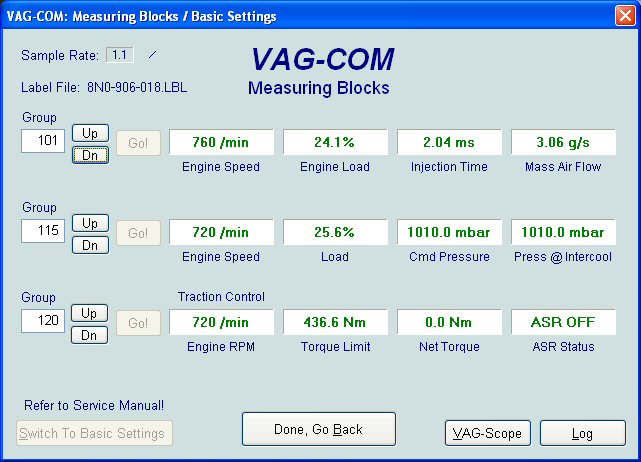
LOGGING
By pressing the "LOG" button you'll get this dialog at the bottom of the screen,
specify a filename and click Start.
All the selected blocks will be logged to a MS Excel compatible CSV file which
can be examined and used for sorting, data manipulation and graphs.

Here are some example CSV files of data collected from a 225
Revo/Milltek Coupe.
Temps - Boost
Below are some other measuring blocks I found, I don't know how useful they are but may have some applications.
Blocks 015/016 - Misfire counts - This would help you identify which coil pack may be failing.
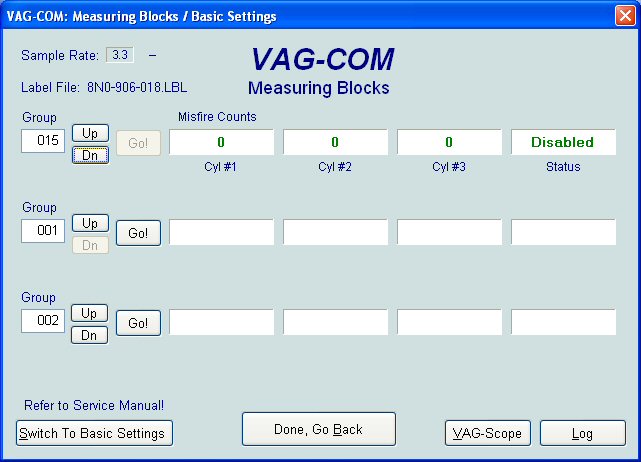
Block 113 - Barometric pressure
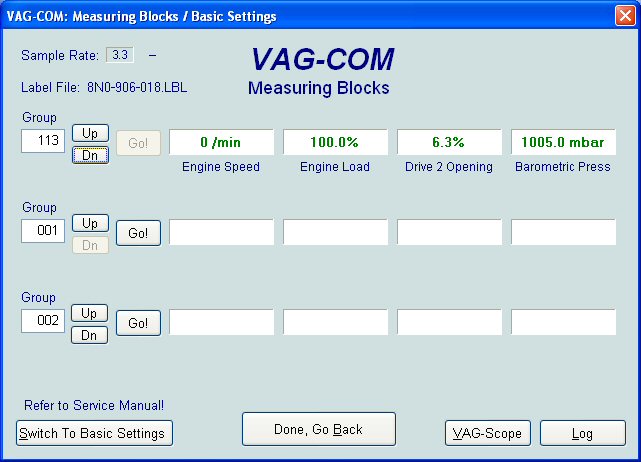
Block 081 - Chassis number + ? ECU code perhaps?
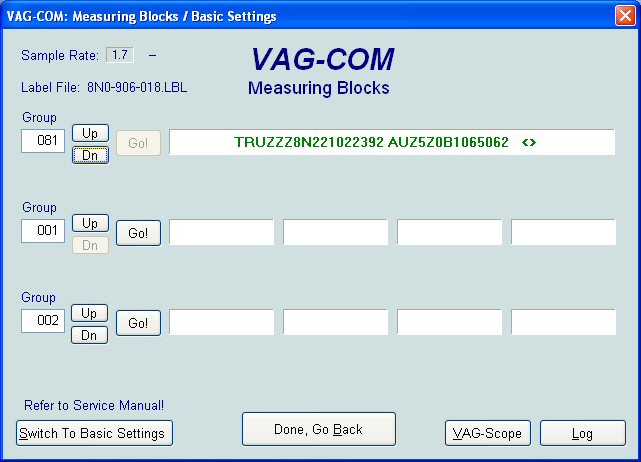
Block 050 - Air Conditioning compressor status - AC diagnostics?
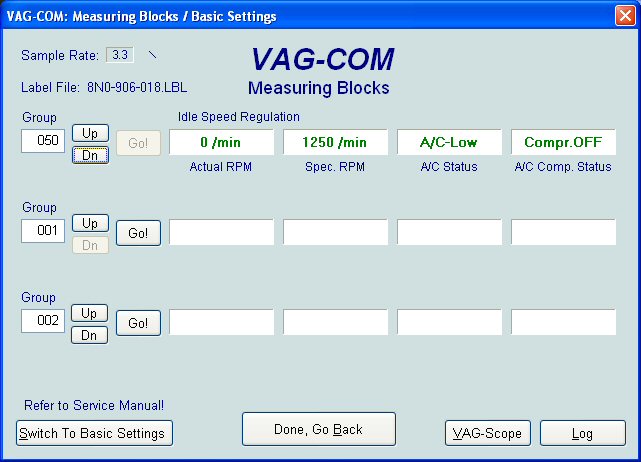
VAG SCOPE - Graphical data display
A free plug-in that comes with the Vag-Com installation is Vag Scope which can be run real time or a created CSV file can be opened and run through the tool to give a relative graph as shown below.
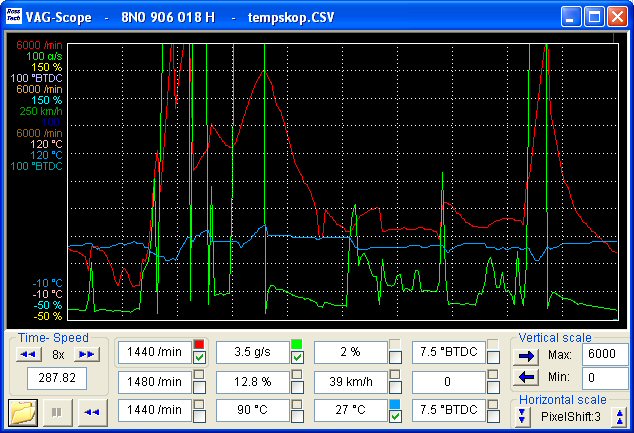
Causes of boost loss:-
Air Mass Meter failure
N75 Wastegate malfunction
Diverter valve malfunction
A physical leak.....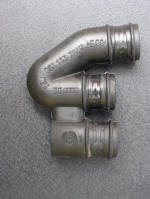
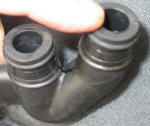
This pipe sits along side the intake manifold and can split, it not only controls boost but a leak can cause low pressure in the braking system.
Forge market a replacement hose for around £20
Part No: FMTB1302
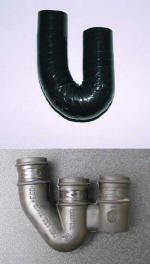
Quote Forge :- If you look at the two images above you will see
that the replacement hose replicates the OEM vacuum hose. The extra piece of
hose on the right hand side of the OEM hose, is not actually used as a hose but
slips over the solid vacuum pipe as a pipe holder.
The Forge-Samco hose is sold as a repair hose which is tape bound for extra
strength and replaces the damaged OEM unit without the need to replace the
entire vacuum pipe system, which is necessary if you were to try to buy the OEM
part.